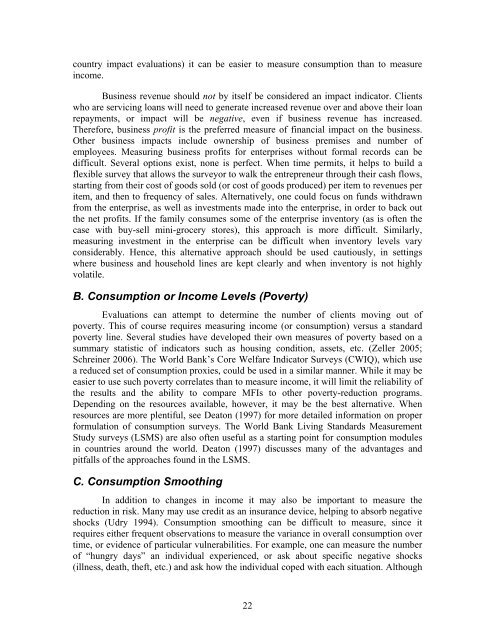Impact Evaluation for Microfinance: Review of Methodological Issues
Impact Evaluation for Microfinance: Review of Methodological Issues
Impact Evaluation for Microfinance: Review of Methodological Issues
You also want an ePaper? Increase the reach of your titles
YUMPU automatically turns print PDFs into web optimized ePapers that Google loves.
country impact evaluations) it can be easier to measure consumption than to measure<br />
income.<br />
Business revenue should not by itself be considered an impact indicator. Clients<br />
who are servicing loans will need to generate increased revenue over and above their loan<br />
repayments, or impact will be negative, even if business revenue has increased.<br />
There<strong>for</strong>e, business pr<strong>of</strong>it is the preferred measure <strong>of</strong> financial impact on the business.<br />
Other business impacts include ownership <strong>of</strong> business premises and number <strong>of</strong><br />
employees. Measuring business pr<strong>of</strong>its <strong>for</strong> enterprises without <strong>for</strong>mal records can be<br />
difficult. Several options exist, none is perfect. When time permits, it helps to build a<br />
flexible survey that allows the surveyor to walk the entrepreneur through their cash flows,<br />
starting from their cost <strong>of</strong> goods sold (or cost <strong>of</strong> goods produced) per item to revenues per<br />
item, and then to frequency <strong>of</strong> sales. Alternatively, one could focus on funds withdrawn<br />
from the enterprise, as well as investments made into the enterprise, in order to back out<br />
the net pr<strong>of</strong>its. If the family consumes some <strong>of</strong> the enterprise inventory (as is <strong>of</strong>ten the<br />
case with buy-sell mini-grocery stores), this approach is more difficult. Similarly,<br />
measuring investment in the enterprise can be difficult when inventory levels vary<br />
considerably. Hence, this alternative approach should be used cautiously, in settings<br />
where business and household lines are kept clearly and when inventory is not highly<br />
volatile.<br />
B. Consumption or Income Levels (Poverty)<br />
<strong>Evaluation</strong>s can attempt to determine the number <strong>of</strong> clients moving out <strong>of</strong><br />
poverty. This <strong>of</strong> course requires measuring income (or consumption) versus a standard<br />
poverty line. Several studies have developed their own measures <strong>of</strong> poverty based on a<br />
summary statistic <strong>of</strong> indicators such as housing condition, assets, etc. (Zeller 2005;<br />
Schreiner 2006). The World Bank’s Core Welfare Indicator Surveys (CWIQ), which use<br />
a reduced set <strong>of</strong> consumption proxies, could be used in a similar manner. While it may be<br />
easier to use such poverty correlates than to measure income, it will limit the reliability <strong>of</strong><br />
the results and the ability to compare MFIs to other poverty-reduction programs.<br />
Depending on the resources available, however, it may be the best alternative. When<br />
resources are more plentiful, see Deaton (1997) <strong>for</strong> more detailed in<strong>for</strong>mation on proper<br />
<strong>for</strong>mulation <strong>of</strong> consumption surveys. The World Bank Living Standards Measurement<br />
Study surveys (LSMS) are also <strong>of</strong>ten useful as a starting point <strong>for</strong> consumption modules<br />
in countries around the world. Deaton (1997) discusses many <strong>of</strong> the advantages and<br />
pitfalls <strong>of</strong> the approaches found in the LSMS.<br />
C. Consumption Smoothing<br />
In addition to changes in income it may also be important to measure the<br />
reduction in risk. Many may use credit as an insurance device, helping to absorb negative<br />
shocks (Udry 1994). Consumption smoothing can be difficult to measure, since it<br />
requires either frequent observations to measure the variance in overall consumption over<br />
time, or evidence <strong>of</strong> particular vulnerabilities. For example, one can measure the number<br />
<strong>of</strong> “hungry days” an individual experienced, or ask about specific negative shocks<br />
(illness, death, theft, etc.) and ask how the individual coped with each situation. Although<br />
22






